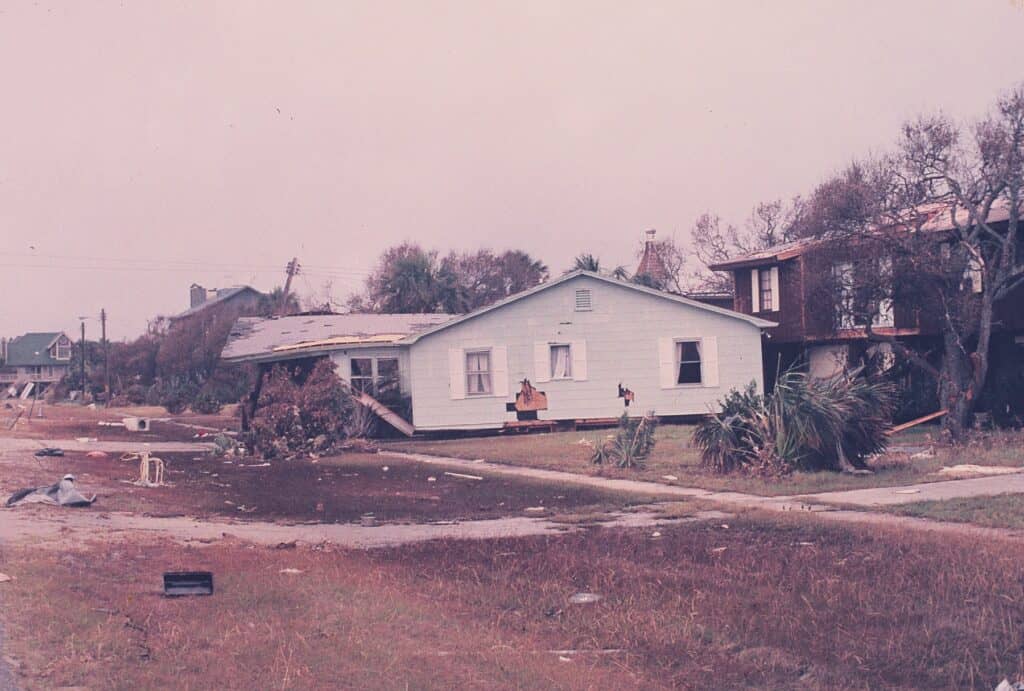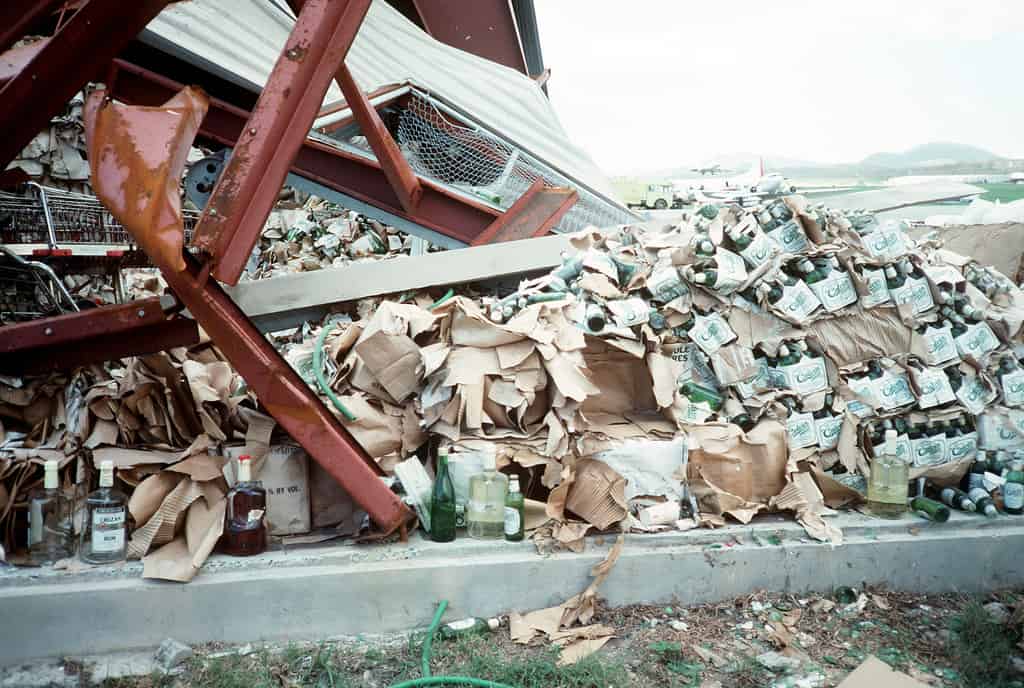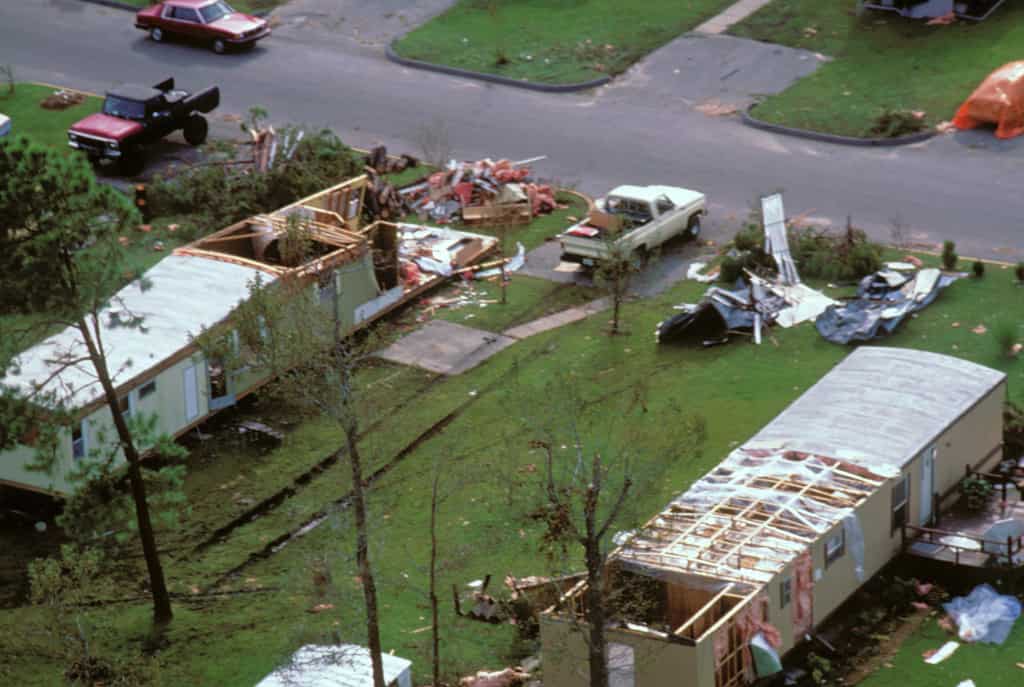The most powerful hurricane to hit South Carolina was Hurricane Hugo and the level of devastation it caused the Palmetto State is difficult to comprehend. Most of the time, when we think about hurricanes, our eyes and minds turn to the Gulf Coast, where such things are prevalent.
However, now and then a hurricane will slip north, along the Atlantic coast. Since hurricanes along the northern portion of the east coast are nowhere near as common as they are along the Gulf Coast and east Florida, those states tend to be proportionately prepared—which is to say, ‘not as well as they should be.’
In recent memory, South Carolina has been on the receiving end of plenty of hurricanes. Though powerful hurricanes struck the state before Hurricane Hugo, only a few can approach Hugo in terms of pure devastation.
History of South Carolina Hurricanes

Destruction from Hurricane Hugo in South Carolina
©SC National Guard / Public Domain Mark 1.0, Flickr – Original / License
There’s always that one hurricane that bears no name. The one that rolls in throughout the late 1800s, wipes the earth clean of all signs of habitation, and maintains an oral remembrance just long enough to land in the pages of a history book.
Such was the case with South Carolina. In 1885, what most meteorologists calculate was a category two hurricane, ran through South Carolina like a hot knife through butter. Back then, it was just one of those things that came along once every so often. Today, it’s known as a storm without a name.
In 1954, Hurricane Hazel grew to a sizeable hurricane, eventually becoming a Category 4, before launching itself at the South Carolina mainland. This time, it was a little closer to South Carolina’s border with North Carolina, causing both states plenty of grief and devastation.
As Hurricane Hazel finally left for greener pastures, there were 95 dead in its wake. Hurricane Gracie held back just long enough to let South Carolina catch a breather, then struck in 1959, with a heavy focus on the shorelines of South Carolina and Georgia.
Though the death toll in the wake of Hurricane Gracie was near a tenth of Hazel, the devastation from the storm surge was immense. Mostly, that’s because it was a very slow-moving storm, spending most of its energy (with the strongest side of the hurricane) hovering over the shoreline and causing a constant, unending storm surge of up to 9 feet.
Hurricane Matthew was more of a blip on the radar—a far weaker, Category 1 storm with plenty of damage left in its wake but nowhere near the catastrophic levels of the previous hurricanes. Then, there was Hurricane Hugo.
Hurricane Hugo – The Hurricane That Nearly Broke South Carolina

A close-up view of a store destroyed by Hurricane Hugo, which devastated the area on September 19th.
© The U.S. National Archives via Picryl.com-Public Domain Mark 1.0 – Original / License
At some point, early in the hurricane season of 1989, a series of thunderstorms were coalescing around the Cape Verde area, brewing a real bruiser—a thundering torrent of raw power that would eventually take 49 lives, create record storm surges, and pick up houses, only to fling them like tiny slivers of kindling into the roaring winds.
Most of the islands that had the unfortunate luck to lie in the path of Hurricane Hugo, would eventually face one of the most destructive east coast hurricanes in their history, as well as that of the US east coast. Despite the evacuations, the repeating warnings and watches, and the understanding that this was a catastrophic hurricane, 35,000 lost their homes.
Montserrat was next, with Hurricane Hugo quickly rising to become the most costly hurricane in the island’s history. Hugo cut its way through the Caribbean, costing billions of dollars in damage, displacing thousands from their homes, and permanently destroying buildings.
Hugo didn’t spare the Virgin Islands or Puerto Rico either, causing over a billion dollars in damage, slamming into the islands with sustained winds of nearly 170 mph. Nine out of ten buildings in Saint Croix didn’t survive the onslaught, displacing another 28,000 people.
South Carolina
South Carolina has dealt with its fair share of hurricanes, both before and after Hurricane Hugo. However, two things were working against the state, along with its northern and southern neighbors. The first was the fact that most hurricanes, up to that point, would move north along the coast, touching land and weakening as they went. Hurricane Hugo didn’t do that, instead sweeping in from the Atlantic and striking South Carolina head-on.
Until then, the strongest hurricane to make landfall in the US, excluding Hawaii and Alaska, was Hurricane Camille. What made Hurricane Hugo so extraordinary, besides the abject fear of the hurricane, was the storm surge.
Not before or since has South Carolina seen a storm surge reaching up to 20 feet. This enormous surge was devastating to islands and the coastal areas along South Carolina’s mainland. Hurricane Hugo made landfall on September 22, 1989, around midnight, packing winds strong enough to label it a Category 4 storm.
By the time it was done, the coastal areas resembled a nuclear wasteland. Over 4 and a half million trees were wiped out, 79,000 homes were damaged, and 35 people were dead. Hurricane Hugo cost South Carolinians somewhere between 7 and 8 billion in damages.
Most Powerful Hurricane in South Carolina History – Aftermath

Aerial view showing the damage inflicted on a trailer park when Hurricane Hugo struck Charleston, South Carolina. The exact Date Shot is Unknown.
©The U.S. National Archives via Picryl.com-Public Domain Mark 1.0 – Original / License
Roughly fifty people lost their lives throughout Hurricane Hugo’s wrath. The strength of Hurricane Hugo was such that hurricane-force winds were felt as far inland as western North Carolina, hundreds of miles from the point of landfall. A full recovery took years to complete.
As is typical with hurricanes at this level, there are just as many deaths (sometimes more) than during the onslaught. Hurricane Hugo cut the power for 80% of the state. The storm surge heights Hurricane Hugo wrought were the highest in the history of the US.
While it is no longer the costliest hurricane in United States history, it is still the costliest in the history of South Carolina. That’s pretty impressive because South Carolina’s history includes 44 hurricanes.
All Things Considered
Hurricane Hugo was the most powerful Hurricane in South Carolina history. Interestingly enough, South Carolina is undergoing a building bonanza along its coastal regions. In the areas where Hurricane Hugo struck the hardest, there are now millions of dollars in beachfront homes.
Of course, that’s the way it always works. People build homes on fault lines, construct shopping centers in the middle of tornado alley, and build beachfront properties along the entire gulf coast. Hopefully, they’ll last and will be there a hundred years from now. Unfortunately, given the history of hurricanes along the gulf coast, east coast, and South Carolina in particular, that’s not likely to happen.
Thank you for reading! Have some feedback for us? Contact the AZ Animals editorial team.








